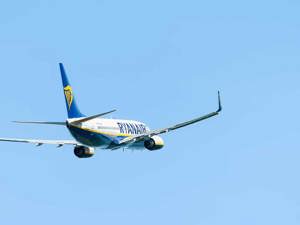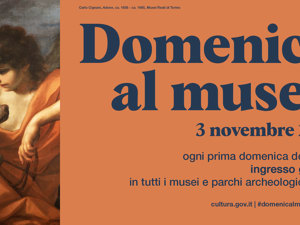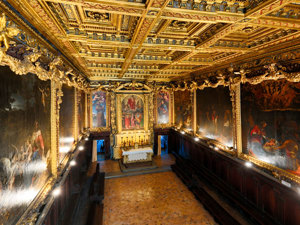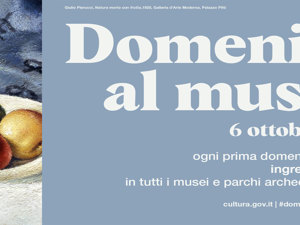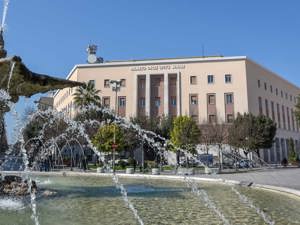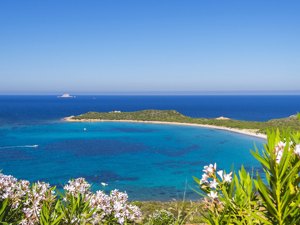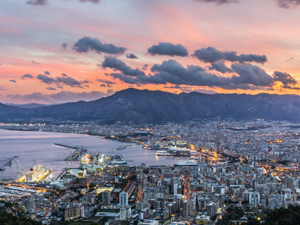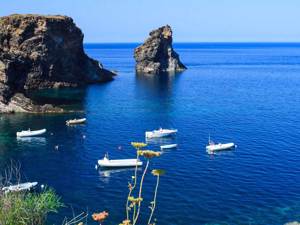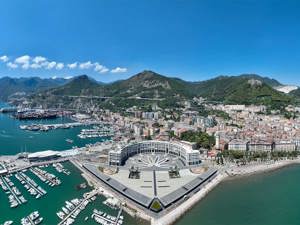A unique port city, a crossroads of peoples and cultures
Since the Romans, Brindisi represented the access to the East. The city have a two millennium history on its back, a life entangled with its port upon which were built the last two columns ending the famous Via Appia. The twin columns date back to II AC and are the symbol of Brindisi; today only one of the pair is still entire, crowned with a capital sculptured in Corinthian order with acanthus leaves, heads of gods and eight Tritons in the corners. The only thing left of the other column is the base.

Brindisi. Photo: Copyright © Sisterscom.com / Sopotnicki / Shutterstock
Brindisi, icon of Puglia, identifies in its cultural heritage the value of centuries-old monuments and treasures.
The Aragonese castle and Swabian castle
The Aragonese Castle, called Fort at Sea, is a red brick fortress built in 1491 on the island facing the port. The Swabian Castle, also called Castello Grande, was built to the commands of Frederick II in 1227 as a fortified residence and since 1909 is in use to the Italian Navy.

Swabian castle, Brindisi. Photo: Copyright © Sisterscom.com / Sopotnicki / Shutterstock
The historical part of Brindisi, still inside the ancient Aragonese walls, contains the old and charming S. Pietro degli Schiavoni district with an archelogical Roman site.
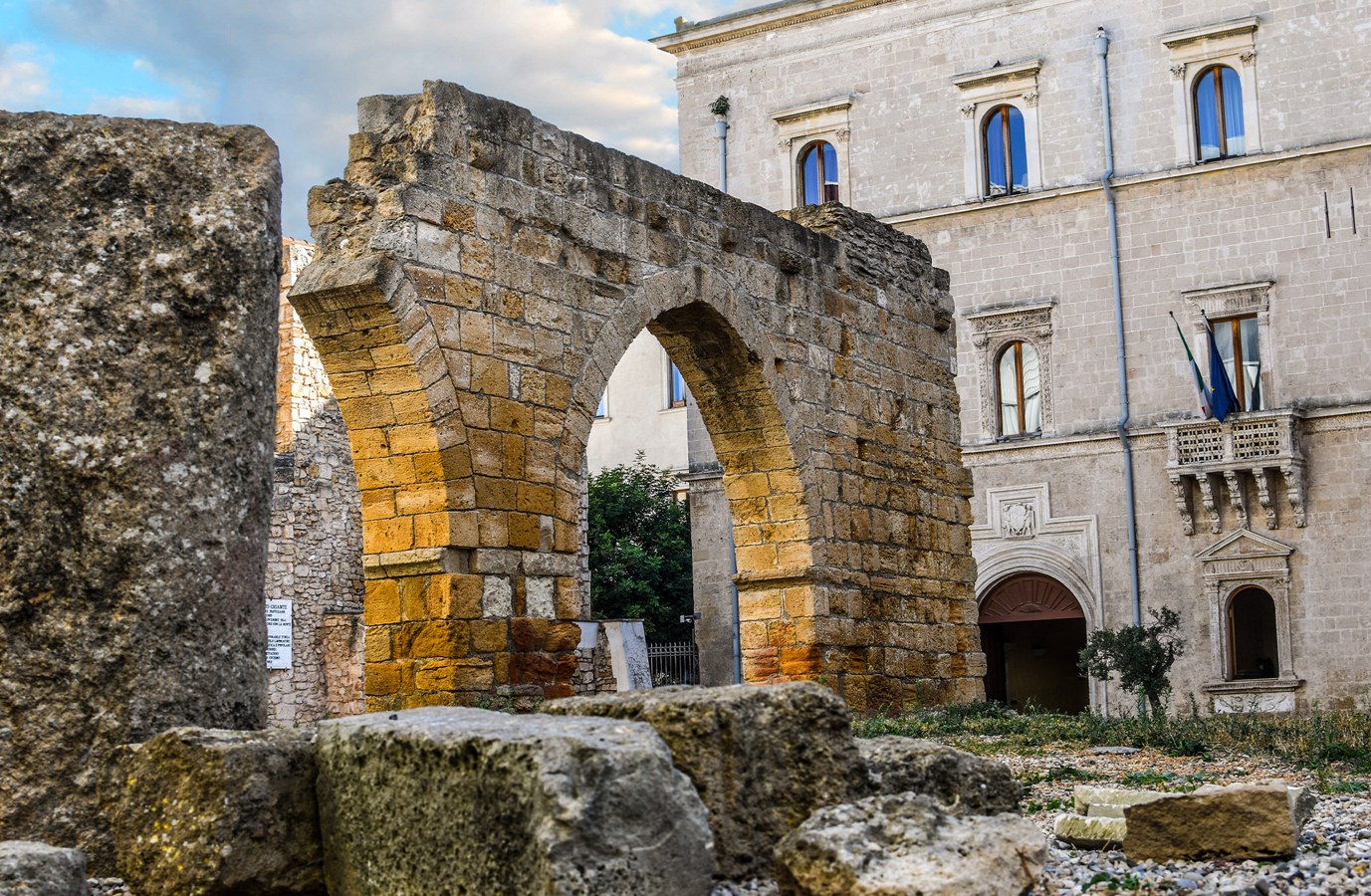
Archaeological area in the historic center of Brindisi. Photo: Copyright © Sisterscom.com / Shutterstock
The former complex of the Pious Schools found in the heart of the historic town centre of Brindisi. The church is dedicated to San Michele Arcangelo, and is characterized by a polychrome tile dome and is currently used as an auditorium or as an exhibition space for exhibitions. The adjoining courtyard retains the premises of the former convent now houses some administrative offices and the Municipal Art Gallery, which has a collection by the illustrious Brindisi artist Armando Scivales.

Church of San Michele Arcangelo. Photo: Copyright © Sisterscom.com / Shutterstock
This historic 16th century building currently houses offices of the city of Brindisi. It is realized with a late Renaissance façade with some elements that would pre-empt the Baroque style. The first floor is devoted to exhibition halls, where the Municipal Government promotes countless exhibitions of great importance. The complex of the former Court of Assizes preserves the original top mountings of the Roman columns.

City of Brindisi overlooking the sea. Photo: Copyright © Sisterscom.com / Shutterstock
The seaside walk, one of the most populated places in Brindisi, goes to the fishermen’s village, where the colours and the culture of the sea shine bright in their originality and traditions.
The Brindisi’s province
From the city on the sea, chief town and at the gate of the East we go to Cisternino “the white”, last village of the Murge and high about 400 meters from sea level, and then to the medieval villages built at the feet of massive castles. The province of Brindisi offers to visitors an extraordinary choice of cultural, historical, natural and gastronomical traditions. An area filled with cathedrals, fortified farms and noble buildings.

Cisternino. Photo: Copyright © Sisterscom.com / Shutterstock
Another feature of unquestioning charm is represented by the small shops of arts and crafts and the music folklore still based upon latin and greek themes and structures. Each of the 20 muicipalities in Brindisi’s province has its peculiar dialect, but a warm welcome and the incredible hospitality are genuine like the fruits that earth gives here: from olive oil to the wines known worldwide.
Text by Angela Trivigno
Avion Tourism Magazine
Photos for editorial use only: Copyright © Sisterscom.com, Shutterstock
All rights reserved. Copyright © Sisterscom.com
Video: www.viaggiareinpuglia.it
Tourism Board
www.viaggiareinpuglia.it
Partnership with Booking.com
Where to sleep in Brindisi

Brindisi. Photo: Copyright © Sisterscom.com / Shutterstock
Brindisi is a welcoming city and offers different possibilities for accommodation.
To find the ideal hotel and the best offers you can do a search for the stars but also for districts or landmarks.
THEME HOTELS
Hotels in tourist areas
AIRPORT
Hotels near the airport
where to go in brindisi
Monuments in Brindisi

Copyright © Sisterscom / Shutterstock
CATHEDRAL SQUARE
Some of the most important monuments of Christianity in Brindisi were conceived and developed here, above all the cathedral. It was dedicated to St. John the Baptist and was rebuilt following the collapse due to the earthquake of 1743. The Cathedral houses the sacred remains of the city's patron saint, St. Theodore of Amasea. On the right side of the Church are the Episcopal Palace and the former Palazzo del Seminario designed in 1720 by Mauro Manieri.

Copyright © Sisterscom / Shutterstock
ARAGONES CASTLE
The Aragones Castle, also know Alfonsino Castle, is located on the islet of S. Andrea, in the outer harbour and opposite the mouth of the channel Pigonati. With a natural defensive bulwark, its construction started in 1445 when Ferdinand I of Aragon commissioned his son Alfonso to construct the castle that currently consists of two fulcrums: the first was constructed by Alfonso and the second was built by Philip II of Austria in 1583.

San Benedetto Church, Brindisi. Copyright © Sisterscom / Shutterstock
SAN BENEDETTO CHURCH
A local Romanesque church built in 1089 and dedicated to Santa Maria Veterana, it is one of the most beautiful monuments in the city of Brindisi. Particular attention should be paid to the internal cloister, characterized by a harmonious alternation of columns with representations of plants and animals mounted at the top. The interior is divided into three naves by small thin grey marble columns and coverage is characterized by beautiful vaults.
Museums of Brindisi
ARCHEOLOGICAL MUSEUM
The Provincial Archaeological Museum “F. Ribezzo", recently reorganised and inaugurated in 2009, displays in various sections the historical and archaeological evidence linked to the territory of Brindisi ranging from Prehistoric times to Roman. It was originally established within the Temple of S. Giovanni in 1884. Initially collecting donations from local collectors, it soon became too small to hold the countless relics found at archaeological digs across the region. It was thought then to build a bigger and more appropriate building.
DIOCESAN MUSEUM
The Museum, named after Giovanni Tarantini a Brindisi Clergyman who had a passion for antiquity, collects important historical, artistic and religious artefacts relating to the city of Brindisi. In the atrium that precedes the exhibition area, fragments of the ancient medieval cathedrals and other churches in the city can be seen, while inside, the reliquary of St. Theodoro of Amasea stands out for its importance and beauty. Important historical testimonies such as a parchment dated 1219 and signed by the Emperor Svevo Federico II.
Excursions and tour in Brindisi

Copyright © Sisterscom / Shutterstock
OASIS OF TOWER GUACETO
Torre Guaceto Oasis stretches on a pristine stretch of coastline north of Brindisi. It covers an area of 1114 hectares and represents a fundamental step in learning about the natural landscape of the territory. The entire area around the Aragonese Tower, built during the 1500s, is part of the all-important defensive system that was developed along the Italian coastline to deal with Turkish and pirate incursions.

Copyright © Sisterscom / Shutterstock
PUNTA DELLA CONTESSA
This regional natural park is a protected area found between Torre Cavallo and the Punta della Contessa and extends for 214 acres south of Brindisi. The whole wetland has a significant influx of migrating species and about 14 have been identified, including breeding waders, swans, herons, coots, mallards, and tufted ducks. The flora consists mainly of rupopia chirrosa, agropyron junceum, ammophilla sp. The area is good for birdwatchers.
Partnership with GetYourGuide
Recommended tours in Brindisi
 Lecce. Copyright © Sisterscom / Shutterstock
Lecce. Copyright © Sisterscom / ShutterstockLECCE
Just 36 km from Brindisi is the city of Lecce famous for its Baroque architecture and one of the most renowned cities in Southern Italy. Once on the spot you can visit the city with a local guide to admire Porta Napoli, Piazza del Duomo (baroque heart of the city), the Church of Sant'Irene, Piazza Sant'Oronzo with the remains of the Roman Amphitheater, the Church of San Marco, the famous Palazzo del Seggio, the Church of Santa Chiara, the Roman Theater, the Baroque Basilica of Santa Croce and the Palazzo dei Celestini. Private walking tour of the city of Lecce with local guide.

Ostuni. Copyright © Sisterscom / Shutterstock
OSTUNI
The city of Ostuni is located just 32 km from Brindisi. Ostuni, known as the white city for the white color of its buildings, can be visited with a tour accompanied on site by a local guide to discover the streets of the old city, glimpses of unique landscapes between the white of the buildings and the blue of the sea and the Cathedral of Santa Maria dell'Assunzione. Ostuni walking tour with local guide.
Discover all tours
News & Useful info
Shopping
You might be interested in
Destinations found in the vicinity
Other destinations
Airports nearby Brindisi





